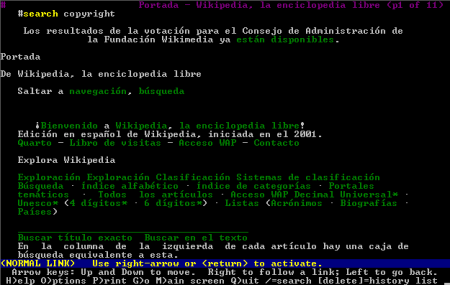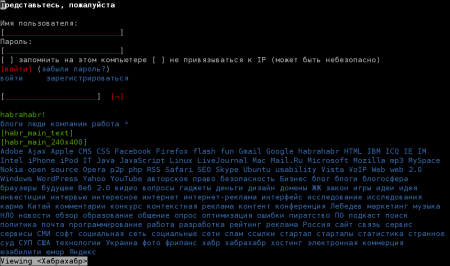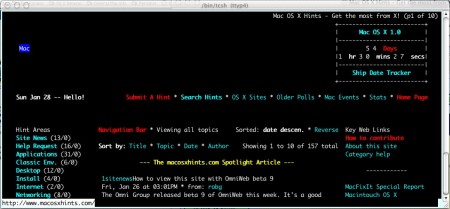Text browsers
While most people discuss the speed and bells and whistles of Firefox, some prefer to browse in text mode.
The history of browsing in text mode has a long history. At the very beginning - another mode did not exist, the browser was one - CERN Line Mode Browser (also called www). Appearing later, Lynx introduced the full-screen mode, not the line, behind the line, as in the distant 1992. Lynx continues to evolve even now. Lynx was originally conceived as a browser for Gopher and some university hypertext systems. Next was Emacs / W3 , released in 1993 and written in Emacs Lisp . In 1998, w3m appeared , the birthplace of which is Japan. And even later, in 1999, the Czech programmer Mikulas Patocka releases Links . Elnks - is a fork of the original Links. Given the incredible rendering speed and the ability to use it remotely, even with an SSH connection through the floor of the earth, text browsing is still popular. We make a small review and evaluate the current state of the available text browsers.

')
The simplest and most common browser, almost certainly stands on any UNIX-like system. What makes it the same standard and easily accessible tool as the editor Vi. Render pages in color or monochrome, supports several encodings, but does not understand frames and behaves strangely with tables.
Current version: 2.8.6 Homepage: http: //lynx.isc.org/

At the time of their appearance, there was another reason why Emacs users should not have left their favorite editor to do other things. It has the same UTF-8 support as Emacs, besides it has an idea of basic CSS (some sources indicate support for CSS1). Unfortunately, the project is somewhat outdated, does not understand XHTML, which leads to the appearance of pieces of code in the rendered pages. Currently requires processing and is not recommended for use.
Homepage: http: //www.gnu.org/software/w3/

Originally conceived as a paginal text output tool (less, more), but with HTML support. In addition, Lynx seemed big and slow at the time, so w3m was a great fit for replacing it. Since then, the situation has changed a bit and now w3m is more severe than Lynx, but by modern standards, this is nothing. w3m was the first browser that worked well with tables, besides it converted frames into tables, which made it possible to declare support for frames. The browser initially had the support of multilingual, as it was not developed in an English-speaking country. UTF-8 support is available. Moreover, there is a possibility for displaying images, the browser can render them in a framebuffer. There is support for tabs.
Current version: 0.5.2 Homepage: http: //w3m.sourceforge.net/

As the name implies, Links was designed as a replacement for Lynx. The browser supports the table, can download files and pages in the background. Development is not conducted at the moment, only bug fixes are released. Unfortunately, UTF-8 support is not complete, and HTTP authentication is not supported.
Current version: 0.98 Homepage: http: //links.sourceforge.net/

The reason for his appearance can be called the cessation of work on the Links. Supports tables, download in background, tabs, partly CSS. The only one of text browsers is tagging for JavaScript support. It is planned to use Mazilovsky JavaScript engine SpiderMonkey. Allows you to customize and extend its functionality through the scripting languages Guile, Perl, Ruby and Lua. Unfortunately, he inherited from UTF-8 the support that was not entirely complete.
Current version: 0.11.4rc1 Homepage: http: //elinks.or.cz/
Applications can find mass.
I, as a web developer, see such an application for them - when making a project, it is important that at the programming stage not be distracted by the visual design of the project. In this way, you can focus on the data and semantics of the generated HTML. Further, when the programming phase is finished, you can proceed to editing the templates and visual design of our project. Also important is the fact that if you adhere to the principle of unobtrusive javascript or try to make a project accessible to people with disabilities, then testing and development in text browsers is extremely helpful.
Yes, I gave my preference to w3m .
Based on: www.linuxjournal.com/article/8148
Modern reincarnation CERN Line Mode Browser: www.w3.org/LineMode
Gopher on Wikipedia: in Russian in English
PS The term "rendering" is not quite suitable for text browsers, but is used in the article as the most closely reflecting the essence of the process.
Story
The history of browsing in text mode has a long history. At the very beginning - another mode did not exist, the browser was one - CERN Line Mode Browser (also called www). Appearing later, Lynx introduced the full-screen mode, not the line, behind the line, as in the distant 1992. Lynx continues to evolve even now. Lynx was originally conceived as a browser for Gopher and some university hypertext systems. Next was Emacs / W3 , released in 1993 and written in Emacs Lisp . In 1998, w3m appeared , the birthplace of which is Japan. And even later, in 1999, the Czech programmer Mikulas Patocka releases Links . Elnks - is a fork of the original Links. Given the incredible rendering speed and the ability to use it remotely, even with an SSH connection through the floor of the earth, text browsing is still popular. We make a small review and evaluate the current state of the available text browsers.
Browsers
Lynx

')
The simplest and most common browser, almost certainly stands on any UNIX-like system. What makes it the same standard and easily accessible tool as the editor Vi. Render pages in color or monochrome, supports several encodings, but does not understand frames and behaves strangely with tables.
Current version: 2.8.6 Homepage: http: //lynx.isc.org/
Emacs / W3

At the time of their appearance, there was another reason why Emacs users should not have left their favorite editor to do other things. It has the same UTF-8 support as Emacs, besides it has an idea of basic CSS (some sources indicate support for CSS1). Unfortunately, the project is somewhat outdated, does not understand XHTML, which leads to the appearance of pieces of code in the rendered pages. Currently requires processing and is not recommended for use.
Homepage: http: //www.gnu.org/software/w3/
w3m

Originally conceived as a paginal text output tool (less, more), but with HTML support. In addition, Lynx seemed big and slow at the time, so w3m was a great fit for replacing it. Since then, the situation has changed a bit and now w3m is more severe than Lynx, but by modern standards, this is nothing. w3m was the first browser that worked well with tables, besides it converted frames into tables, which made it possible to declare support for frames. The browser initially had the support of multilingual, as it was not developed in an English-speaking country. UTF-8 support is available. Moreover, there is a possibility for displaying images, the browser can render them in a framebuffer. There is support for tabs.
Current version: 0.5.2 Homepage: http: //w3m.sourceforge.net/
Links

As the name implies, Links was designed as a replacement for Lynx. The browser supports the table, can download files and pages in the background. Development is not conducted at the moment, only bug fixes are released. Unfortunately, UTF-8 support is not complete, and HTTP authentication is not supported.
Current version: 0.98 Homepage: http: //links.sourceforge.net/
Elinks

The reason for his appearance can be called the cessation of work on the Links. Supports tables, download in background, tabs, partly CSS. The only one of text browsers is tagging for JavaScript support. It is planned to use Mazilovsky JavaScript engine SpiderMonkey. Allows you to customize and extend its functionality through the scripting languages Guile, Perl, Ruby and Lua. Unfortunately, he inherited from UTF-8 the support that was not entirely complete.
Current version: 0.11.4rc1 Homepage: http: //elinks.or.cz/
Why it might be necessary?
Applications can find mass.
I, as a web developer, see such an application for them - when making a project, it is important that at the programming stage not be distracted by the visual design of the project. In this way, you can focus on the data and semantics of the generated HTML. Further, when the programming phase is finished, you can proceed to editing the templates and visual design of our project. Also important is the fact that if you adhere to the principle of unobtrusive javascript or try to make a project accessible to people with disabilities, then testing and development in text browsers is extremely helpful.
Yes, I gave my preference to w3m .
Links
Based on: www.linuxjournal.com/article/8148
Modern reincarnation CERN Line Mode Browser: www.w3.org/LineMode
Gopher on Wikipedia: in Russian in English
PS The term "rendering" is not quite suitable for text browsers, but is used in the article as the most closely reflecting the essence of the process.
Source: https://habr.com/ru/post/26645/
All Articles